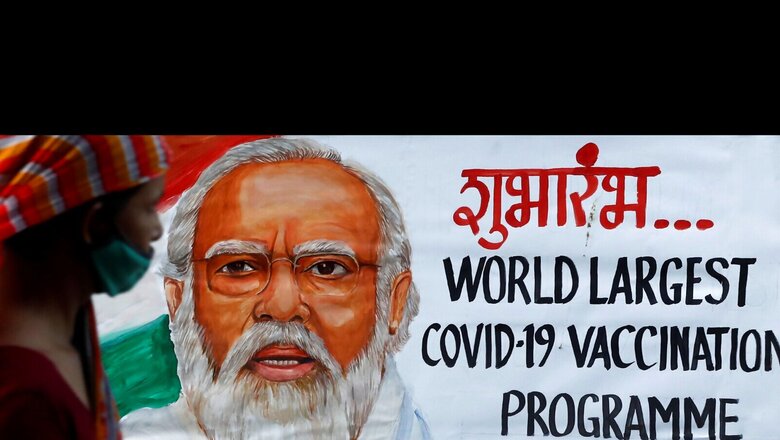
views
Let’s rewind the clock and go back to 2014. In the past eight years of the Narendra Modi-led government, health has become a visible part of the development discourse in the country and it does not just include the pandemic-induced emergencies.
Much before the arrival of Covid-19, in the Modi government’s first term, the healthcare sector allocation was increased by an average of over 20 per cent with every budget.
This apportionment was much more than the preceding UPA 2 government led by Manmohan Singh, where the annual hike hovered around 12 per cent.
The first full budget of the second Modi government gave a 23 per cent higher allocation for health than the 2018-19 budget – marking the continuation of the trend of increased allocations.
Not only budget hikes but PM Modi and his government are also credited with the launch of Ayushman Bharat – the scheme which is touted as the world’s largest health insurance scheme that covers the most vulnerable bottom population of India.
Apart from bringing the focus on the concept of universal health coverage, the government launched the National Health Policy of 2017 and began discussing the need for investment in preventive and primary healthcare.
In 2017, the government slashed the prices of coronary stents by as much as 85 per cent. In 2019, prices of 400 anti-cancer drugs were slashed by capping their trade margins. Many more such moves are on the cards.
According to health experts, a commendable feature of the last eight years in the health sector was an effort to ensure continuity in policy— the slow gains of the UPA era were being carefully consolidated, accelerated, and taken to the logical next step.
Initiatives like Ayushman Bharat Health Infrastructure Mission, Ayushman Bharat-Pradhan Mantri Jan Arogya Yojana, Ayushman Bharat Digital Mission (ABDM), Ayushman Bharat Health and Wellness Centres, Pradhan Mantri Swasthya Suraksha Yojana (PMSSY) and Pradhan Mantri Bharatiya Janaushadhi Pariyojana (PMBJP) built on and took forward the healthcare agenda of the last decade.
“Traditionally, health has been a neglected area of social policy in India. Political visibility of health as a policy concern has been the highest in the last eight years, and it is hoped that it will ensure sustainability and expansion of many schemes towards universal access,” said Oommen C Kurian, senior fellow and head of the health initiative, Observer Research Foundation (ORF).
In addition, the Modi government has been working silently over the last decade on converting the social determinants of health (SDH) framework into practice, with flagship interventions in key areas such as nutrition (National Nutrition Mission), drinking water (Jal Jeevan Mission), indoor air pollution (Ujjwala Yojana), sanitation (Swachh Bharat), road access (Gram Sadak Yojana), and gender (Bet Bachao, Beti Padhao), Kurian noted.
“These experiences can potentially offer policy templates for many other counties in the years to come,” he said.
While the Modi government’s high-pitched rhetoric in election rallies has been on “affordable healthcare”, some of it has been done and a lot has to be done.
However, despite the pandemic experience teaching us the primacy of decentralised health infrastructure, budgetary allocation to foundational initiatives like National Health Mission has not seen a substantial improvement, which remains an area of concern.
Biggest fight against Covid-19
Completing eight years as Prime Minister, the most crucial fight Narendra Modi and his government faced was against Covid-19. The fight wasn’t just crucial because of the nature of the pandemic but due to several other reasons including the sad state of affairs of the health infrastructure across India, negligible medical care systems in remote areas to handle emergencies, and its densely populated cities.
Ignoring the controversial debate between India and the World Health Organization (WHO) over the total death toll due to Covid and trusting India’s official count of 5.24 lakh, PM Modi remains on a firm footing and in a pole position ahead of the general elections in 2024.
According to Dr NK Arora, head of the National Technical Advisory Group on Immunisation (NTAGI) – an apex panel that takes critical decisions on the use and deployment of Covid vaccines in India – the top highlight of the pandemic management was community engagement induced by the apex leadership of PM Narendra Modi. “It was by design and not by default,” he told News18.com. “Without the engagement of the community, it wasn’t possible to vaccinate the entire country and win the battle against Covid-19.”
Unless 130 crore people fought together and adhered to protocols of masking, lockdown, and other things apart from accepting vaccines, India had a weak chance against Covid-19, he pointed out.
“Nowhere in the world 97% of the population (as dense as India’s size) is vaccinated. It all started with the right messaging and directions from the apex leadership of India,” said Arora.
PM Modi’s vision and ‘mool mantra’ (core philosophy) of ‘Atmanirbhar Bharat’ (self-reliant India) played a key role as “we did not ask for even a single dose of vaccine from other countries, we were never on our knees. In fact, we ended up doing vaccine exports under ‘Vaccine Maitri’ and in the future, will continue to do that. This is how we won against Covid19,” Arora added.
Future of healthcare is digital
On August 15, 2020, PM Modi announced the launch of the Ayushman Bharat Digital Mission following which India rolled out a platform consisting of digital registries of health providers and health facilities, unique health identity, consent framework, and universal access to health facilities.
“Ayushman Bharat Digital Mission will put us in a position to fight pandemics like Covid even better. Similar to UPI in fintech, the launch of health ID is one of the biggest achievements in the healthcare industry – the last big sector waiting to go digital,” said Deepak Tuli, co-founder and COO of Eka Care, one of the selected companies working along with the government in digitising health records, creation of health IDs.
“There is a humongous opportunity to deliver solutions for connecting doctors, and patients on a digital platform on top of digitised health records. If done right, India could become a benchmark and a case study for other countries to look up to. We have started the project at an absolutely right time, now the need is to sustain the momentum,” he said.
The central government in 2018 launched the National Health Stack – a scheme to create a master health database of the nation in the form of health IDs. It was put on the backburner and expedited only after the outbreak of the pandemic as a digital health mission. However, according to experts, India is moving towards achieving its next UPI moment.
Showstopper: India’s pharma sector
The key initiatives taken under the Modi government in the pharmaceutical sector such as the profit-linked incentives (PLI) scheme have been hailed by the industry.
The dependence of India on Chinese raw materials and subsequent supply disruptions from a single source required the country to look at policies that would secure its supply issues.
“The Modi government recognised the need to revive the domestic bulk drugs manufacturing industry and announced a PLI scheme for raw-materials (API/KSM) manufacturing and promotion of domestic manufacturing of 53 critical bulk drugs and intermediates in the country with a budget of Rs 6,940 crore for the next eight years,” said Sudarshan Jain, secretary general, Indian Pharmaceutical Alliance (IPA), the biggest lobby of drugmakers in India.
To further strengthen the industry, the government launched the production-linked incentive scheme for pharmaceuticals (PLI2.0). The scheme is aimed at creating global champions out of India who have the potential to grow in size and scale using cutting-edge technology and thereby penetrate the global value chains.
While India has been known as a copycat drugmaker, the advent of Covid-19 made the Modi government learn the importance of a strong research and development culture. Jumping on the opportunity, the government has formed a committee on ‘Innovation and R&D’ under the Department of pharmaceuticals.
According to Ashok Madan, an industry expert and executive director of the Indian Drug Manufacturers’ Association (IDMA), the Modi government has significantly promoted the ease of doing business and many redundant rules are being removed.
“The industry, for long, had been asking for a single window. This, in a way, is now possible with union minister Mansukh Mandaviya at the helm of affairs,” he said. “The moves taken by the government in the last eight years following the PM’s vision include the impetus given to research and development.”
For the first time, said Madan, a huge amount of allocation has been given to promote the pharma and medical devices sector including Rs 6,940 crore for PLI 1 and Rs 15,000 crore for PLI 2.
“Now, the industry is very much looking forward to R&D initiatives to promote the scientific temper of the sector,” he said while praising the handholding by PM Modi. “We must not forget that Vaccine Maitri served more than ninety countries during the pandemic. It’s a huge achievement.”
To further enhance the market access of Indian pharmaceutical products, the country is forging free trade agreements (FTAs) with countries. For instance: UAE Comprehensive Economic Partnership (CEPA) and India-Australia Economic Cooperation and Trade Agreement (ECTA).
“The industry aspires to be $120-130 billion by 2030, from the current $44 billion in 2021,” Jain from IPA said while adding that continued collaboration between the government and the industry would be key to achieving this. “These collaborative efforts have helped us in ensuring uninterrupted supply of medicines and encourage us to keep working together for the common cause of patient welfare.”
From nowhere to everywhere: Growth story of Ayush
As soon as the Modi government took over, the ministry of Ayush was conceived the same year with a vision of “reviving the profound knowledge of traditional Indian systems of medicine and ensuring the optimal development and propagation of the Ayush systems of healthcare”.
Ayush is an acronym for traditional and complementary systems of medicine followed in India: namely Ayurveda, Yoga and Naturopathy, Unani, Siddha and Sowa-Rigpa, and Homoeopathy.
According to government officials in the ministry of Ayush, PM Modi is personally fond of using natural therapies. “He will never miss his yoga schedule unless he is on foreign visits. He has hardly consumed any allopathic medicines. He trusts herbal and traditional medicines,” an official from Ayush said.
The role of the ministry of Ayush came into the spotlight during the outbreak of Covid-19 when multiple advisories were released on the use of traditional systems for boosting immunity.
Now, according to Vaidya Rajesh Kotecha, secretary, ministry of Ayush, India is witnessing a very “solid” undercurrent of adoption of herbal medicines and practices, especially after the outbreak of Covid-19.
According to an internal survey of the ministry via its app Ayush Sanjeevani, 90 per cent of the participants used traditional practices and medicines during the pandemic.
“According to the impact-assessment study, out of 1.37 crore respondents, 89.9% used the Ayush practices. This is huge,” Kotecha earlier told News18.com.
Not only in terms of adoption, but the market value of Ayush-based products has also soared by six times in the last seven years.
In 2014, a study showed that the market size of Ayush-based products was around $3 billion or Rs 22,000 crore. A new study by the policy research institute RIS shows that by 2020, the market had already grown to $18.1 billion or Rs 1,40,000 crore.
In April, PM Modi, along with World Health Organization director-general Dr Tedros Ghebreyesus, officially announced the first-of-its-kind WHO Global Centre for Traditional Medicine (GCTM) in Gujarat — bringing India on the international map as a powerhouse of traditional medicines.
Read all the Latest India News here



















Comments
0 comment